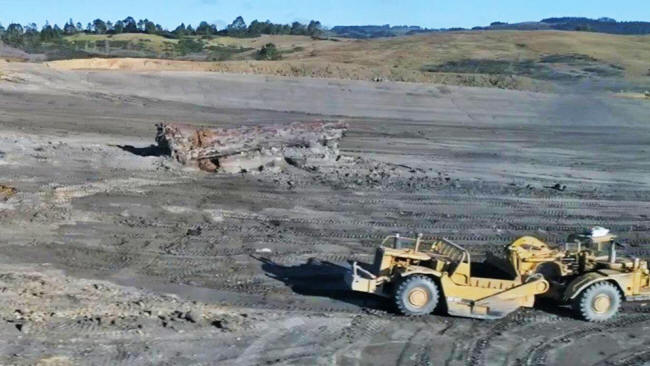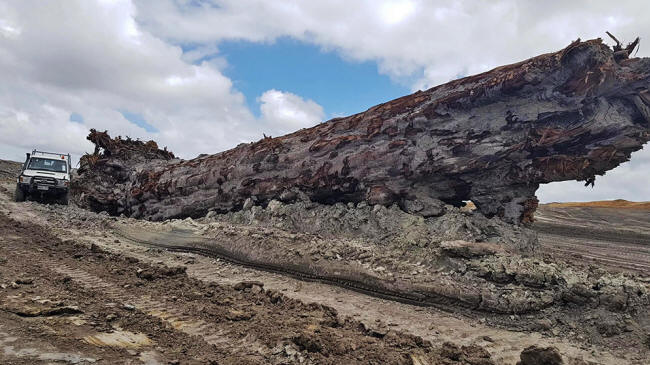|

by Hannah Osborne
July 04,
2019
from
NewsWeek Website

The ancient kauri tree
was uncovered during excavations
at Ngāwhā for a geothermal power
plant expansion.
Tonkin +Taylor
Source
An ancient tree that contains a record of a reversal of Earth's
magnetic field has been discovered in New Zealand.
The tree - an
Agathis australis, better known as
its Māori name kauri - was found in Ngawha, on New Zealand's
North Island, during excavation
work for the expansion of a geothermal power plant,
stuff.nz reports.
The tree, which had been buried in 26 feet of soil, measures eight
feet in diameter and 65 feet in length.
Carbon dating revealed it
lived for 1,500 years, between 41,000 and 42,500 years ago.
"There's nothing like
this anywhere in the world," Alan Hogg, from New Zealand's
University of Waikato, told the website.
"This Ngāwhā kauri is
unique."
The lifespan of the kauri
tree covers a point in Earth's history when the magnetic field
almost reversed.
At this time, the
magnetic north and south went on an excursion but did not quite
complete a full reversal.
Earth's magnetic field is thought to be generated by the iron in the
planet's core. As it moves around, it produces electric currents
that extend far into space. The magnetic field acts as a barrier,
protecting Earth from
the solar wind.
This is a stream of
charged particles from
the Sun that could strip away the ozone layer
if it were to impact the atmosphere.
When the
magnetic field reverses - or attempts to - it gets weaker,
leading to more radiation from the Sun getting through.
Previously,
scientists have
linked extinction events to magnetic field
reversals.
The newly discovered kauri tree's rings contain a complete record of
a near-reversal - the first time a tree that lived during the entire
event has ever been found.
"It's the time it
takes for this movement to occur that is the critical thing...
We will map these changes much more accurately using the tree
rings," Hogg told stuff.nz.

The kauri tree unearthed
during
the expansion of the
Ngāwhā
Generation geothermal power plant.
Nelson
Parker
Samples of the tree are now being analyzed by scientists, led by
Chris Turney from the University of New South Wales - an expert
in paleoclimatology and climate change.
Understanding what
happened to the tree during the event could provide an insight into
what we should expect the next time it happens.
"We will have
increased cosmic radiation. It will take out satellites and it
might take out other communication infrastructure," Hogg said.
Turney told Newsweek:
"The precious thing
is this huge, lonely tree grew for some 1700 years across a
remarkable period in our planet's history when the Earth's
magnetic field flipped some 42,000 years ago, a period known as
the
Laschamp Excursion.
Funded by the
Australian Research Council we're undertaking detailed
measurements of the radioactive form of carbon through the tree
rings."
Magnetic field reversals
happen at random intervals, although in the last 20 million years it
appears to have settled into a pattern, happening once every 200,000
to 300,000 years, NASA says.
The last full reversal
took place around 780,000 years ago.
Scientists recently announced the
magnetic north pole had moved unexpectedly.
Instead of tracking
steadily from the Canadian Arctic towards Siberia, it sped up so
much that researchers had to update the World Magnetic Model
(WMM)
- a representation of Earth's magnetic field that is used by GPS
systems worldwide.
"Because the Earth's
magnetic field has a major effect on how much radiocarbon carbon
is formed in the upper atmosphere, these precious analyses will
allow us to investigate the magnitude and rate of change when
the magnetic field reversed during the Laschamp.
This was something
not possible before and of great interest given recent changes
in the Earth's magnetic field," Turney said.
| 


